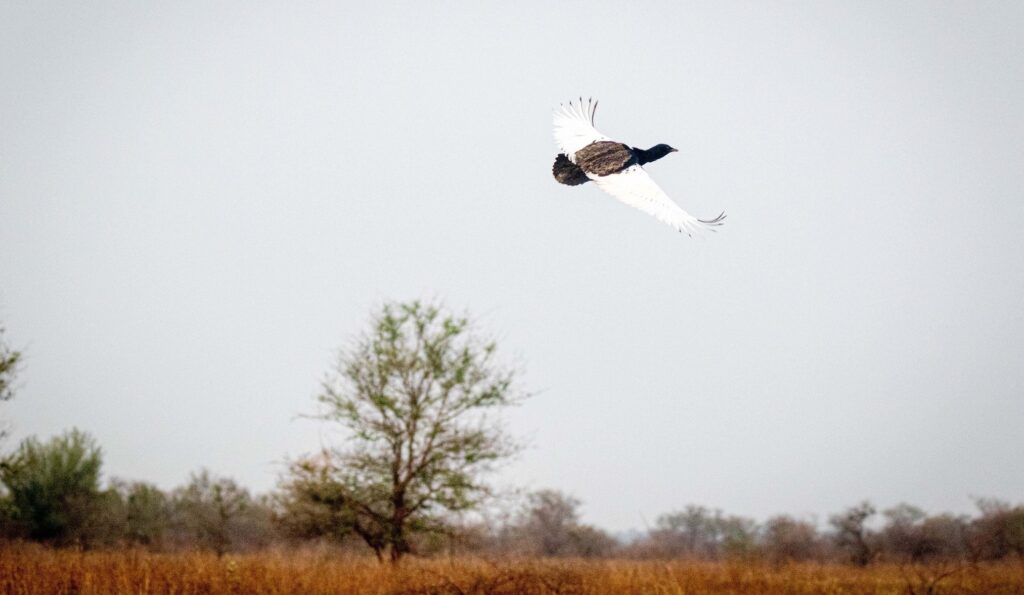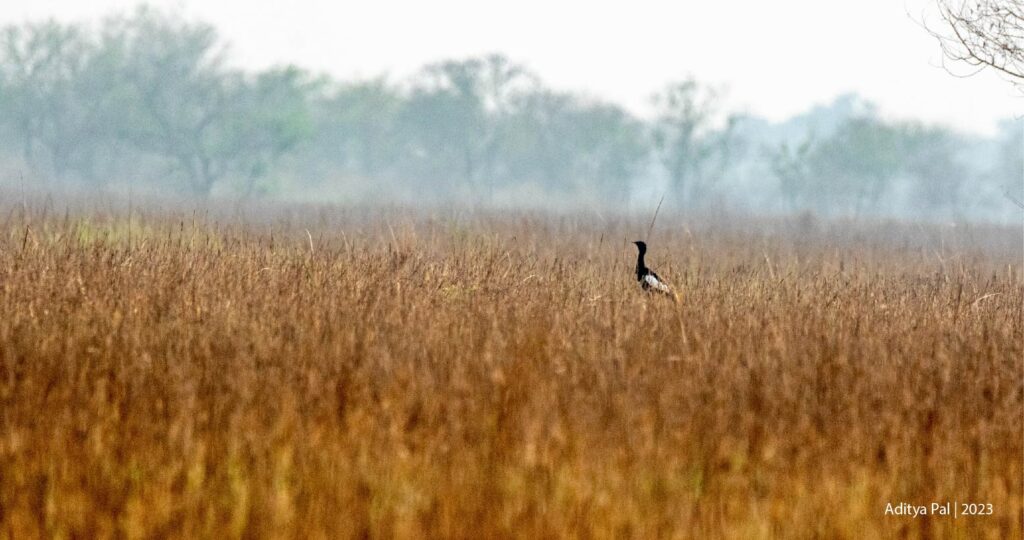Bengal Florican
The Bengal Florican is a highly threatened and rare bustard, classified as Critically Endangered by the IUCN. It has two isolated populations: one in South East Asia, specifically Cambodia (subspecies Houbaropsis bengalensis blandini), and another in South Asia, covering India and Nepal (subspecies Houbaropsis bengalensis bengalensis). With fewer than 1,000 mature individuals remaining, it is already extinct in Bangladesh and Vietnam. India likely has a higher population than Nepal, but no recent population estimates are available. In Nepal, the Bengal Florican is restricted to areas in and around Protected Areas (PAs), with fewer than 100 individuals remaining, making them highly vulnerable to local extinction.
This solitary, territorial bird is a habitat specialist, favoring open short alluvial grasslands with scattered bushes. The primary threats to its survival include the loss and degradation of Terai grasslands both within and outside PAs. Until recently, limited information on its population status and ecology was available, primarily from the breeding season when the bird is more visible during display flights. However, recent satellite telemetry studies in Nepal and India have provided insights into its ecology, habitat requirements, and seasonal movements, especially during the non-breeding season.
The Bengal Florican belongs to the order Gruiformes, suborder Otides, and is further classified under the family Otididae, which comprises 11 genera and 24 species worldwide. Six species are found in South Asia, with two species in Nepal. Initially described by Gmelin in 1789 as Otis bengalensis, it has undergone various taxonomic changes. It was termed Sypheotis bengalensis by Blanford (1898) and Houbaropsis bengalensis by Baker (1929). The current accepted name is Houbaropsis bengalensis, with two recognized subspecies: H. b. bengalensis and H. b. blandini.
Click of different part of the image to know more about it.
A Bengal Florican male, female, and egg in their natural grassland habitat.

Egg
Bengal Florican nests are exceptionally difficult to locate, as the eggs are laid directly on the ground. During incubation, the female remains motionless, blending into the surroundings. Occasionally, Bengal Floricans lay their eggs in dried rice fields, which poses a threat as the harvesting season for dry-season rice coincides with their breeding period.
Female
The female Bengal florican is buff-brown, similar to the male’s back, with a dark brown crown and narrow dark streaks down the sides of her neck. Her wing coverts are lighter than the remiges and feature fine dark barring. Immature Bengal floricans resemble the females.
Male
Adult males have a black head, neck, and underparts, with a distinct white wing patch that is clearly visible in flight.
Systematic classification
Kingdom: Animalia
Phylum: Chordata
Class: Aves
Order: Gruiformes
Family: Otididae
Genus: Houbaropsis
Species: begalensis
Subspecies: bengalensis
Nepali Name: खरमुजुर


Save Bengal Florican
Bengal Florican Project
Bengal Florican Project is a comprehensive conservation initiative dedicated to safeguarding the critically endangered Bengal Florican (Houbaropsis bengalensis), a species native to the grasslands of Nepal and parts of South Asia. This project is driven by four key objectives, each crucial to ensuring the survival of this rare bird species.
Habitat Conservation
The Bengal Florican Project prioritizes the preservation and careful management of the grasslands that are vital to the Bengal Florican’s survival. This objective involves identifying and protecting key areas where the species thrives, and promoting sustainable land-use practices to prevent habitat loss and degradation. By securing these grasslands, the project ensures a safe and suitable environment for the Bengal Florican to continue its existence.


Research and Monitoring
A key focus of the project is ongoing research and monitoring to gain a deeper understanding of the Bengal Florican’s behavior, population trends, and the various threats it faces. This continuous data collection is essential for crafting informed and effective conservation strategies. By keeping a close watch on the species and its environment, the project can adapt its approaches to better protect the Bengal Florican over time.
Community Involvement
Engaging local communities is a crucial element of the Bengal Florican Project. This objective emphasizes the importance of involving those who live near the species’ habitats in conservation efforts. Through educational initiatives and active participation, the project raises awareness about the Bengal Florican and fosters a sense of responsibility among local populations. By empowering communities to take part in habitat protection and monitoring, the project builds local capacity and ensures that conservation efforts are sustainable in the long run.


Policy Advocacy
The project is committed to advocating for strong conservation policies that benefit the Bengal Florican. By working with governments, conservation organizations, and international entities, the project seeks to influence policies that safeguard the species and its habitat. This includes efforts to integrate the Bengal Florican into global conservation agreements and secure legal protections at the national level. Through policy advocacy, the project aims to create a supportive framework for the long-term conservation of the Bengal Florican.
Project Funded By
